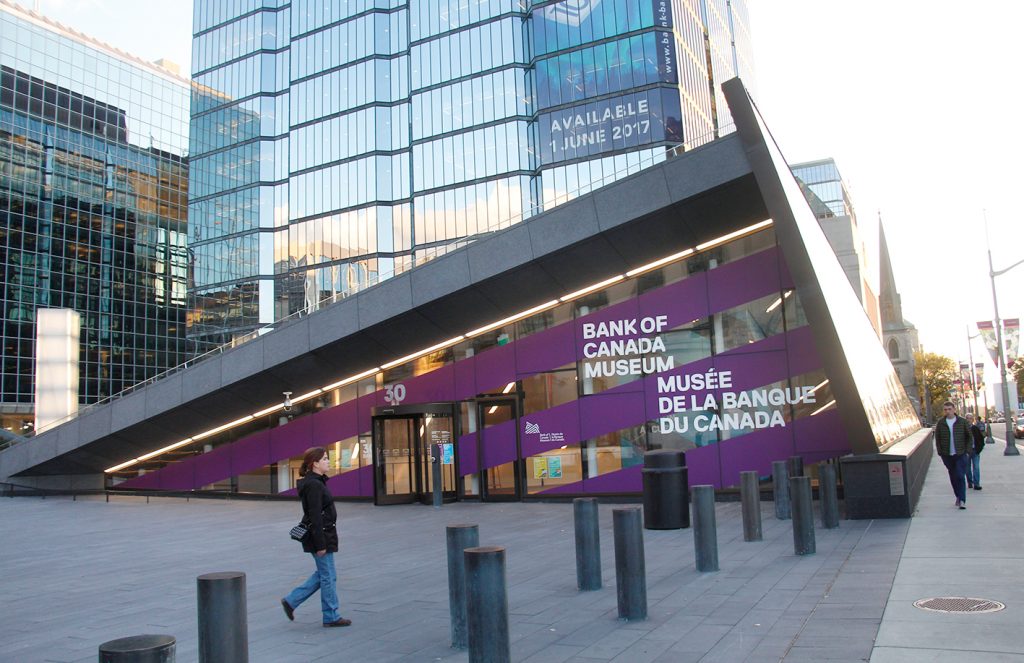Bank of Canada Museum opens e-money exhibit to educate Canadians
By Yana Fedyanova
The Bank of Canada Museum is hosting the exhibit Decoding E-Money to educate Canadians about the modern-day gold rush known as Bitcoin, and other forms of digital currency.
Caroline Roberts, exhibition and program planner at the downtown museum, said the idea behind the exhibition is to raise awareness on the subject of e-money and alternative currencies.
“We first conceived the idea in 2014 as the Bank of Canada was taking an increased interest in cryptocurrency. The Bank of Canada, along with other central banks around the world, is investing in research on digital currencies so this was, for us, a timely subject,” said Roberts.
Cryptocurrency is a form of money that’s entirely electronic and uses computer code instead of printed paper or coins. It emerged in 2009 with the creation of Bitcoin – the first decentralized digital currency.
Currencies are traditionally regulated by their nation’s central bank. In Canada, the Bank of Canada regulates the Canadian dollar. However, Bitcoin operates beyond the oversight of a central bank or intermediary – making it a decentralized form of currency.
Mohamed Al Guindy, a Carleton University business professor who specializes in finance, has been closely studying the rise of cryptocurrency.
“It goes from your digital wallet to someone else’s digital wallet, it’s almost instant and there is no institution behind it,” said Al Guindy. “The funny part is that it doesn’t belong to anybody, it’s a global currency that bypasses all the systems.”
Conventional currencies such as the Canadian dollar or the European Union’s Euro may slightly fluctuate in value, based on supply and demand in the foreign exchange market. These currencies don’t tend to rise or fall excessively and remain rather constant in value.
Al Guindy says Bitcoin can very rapidly jump or drop in value.
“It seems be driven by an excessive demand, and partially because its new and its not well known or understood, its almost like a gold rush that we’re seeing. As long as people are willing to pay a certain amount of dollars for it, then that becomes the value.”
The museum, formerly known as the Canadian Currency Museum, re-opened in July 2017 after under-going a four-year renovation.
The exhibit showcases the history of how currency developed and evolved over time in Canada.
It features tokens used in exchange for fur goods, followed by gold, silver and copper coins, which were used as a legal form of currency. It also exhibits paper currency, which was created to represent large numbers of coins, as well as cheques and bills that were handwritten upon the establishment of banks in Canada in the early 1800s.
Electronic payment cards, such as credit and debit cards that use magnetic strips and microchips, came into play more recently, dramatically changed the way Canadians pay for purchases.
Bitcoin represents another disruptive change in the evolution of currency.
To fit the exhibit’s modern theme of electronic money, the displays themselves use contemporary technology such as touch-screen panels and video games to engage its visitors.
Anita Lodi, a recent visitor to the museum located at the corner of Bank and Wellington streets, said she’d heard of cryptocurrency but didn’t understand how it operated until she saw the exhibit.
“I’ve heard of Bitcoin before because everyone has been talking about it, but I had no idea what it actually was until I came here,” she said. The exhibit is also really interactive so it helped clear things up for me.”
Decoding E-Money uses hands-on activities such as an interactive payment systems map that shows the routes money takes using different payment methods. There’s also a true-or-false video game, which allows up to four users at a time to test their knowledge of cryptocurrency.
Roberts said informing visitors about trends in the world’s financial system is an important part of the mandate of the Bank of Canada Museum.
“Technology is evolving rapidly and the Bank of Canada is watching the developments closely,” she said. “We hope that our visitors will have a greater awareness of how existing payment systems work, and how new technology is changing the way we pay.”
The exhibit will be on display until April 22.

